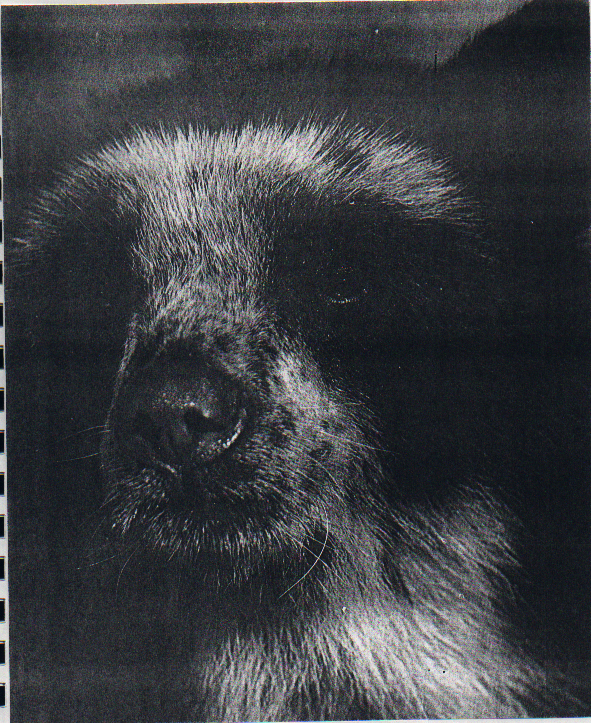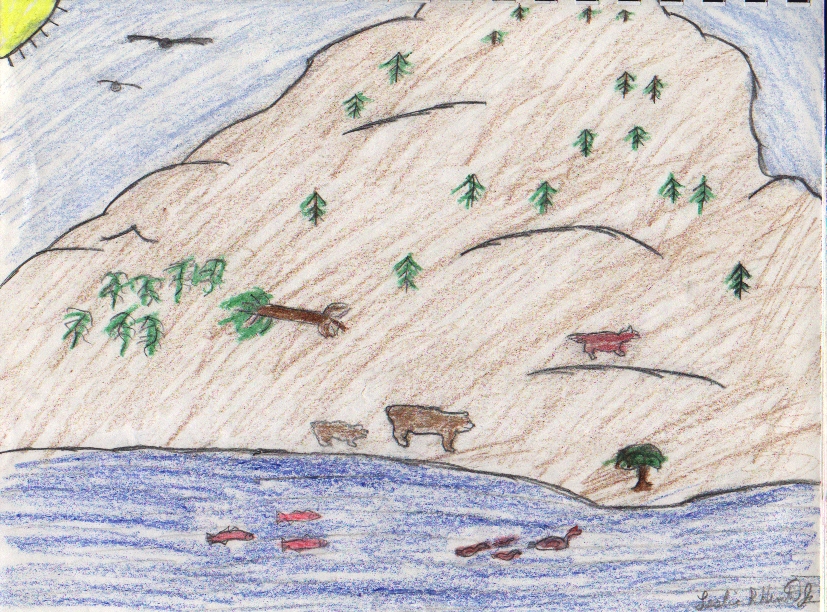 Marshall
Cultural Atlas Marshall
Cultural Atlas
This collection of student work is from
Frank Keim's classes. He has wanted to share these works for others
to use as an example of Culturally-based curriculum and documentation. These
documents have been OCR-scanned. These are available
for educational use only.


Spectacled Bears
Tremaretos ornatus
The only species of bear living in South America is the Tremarctos
ornatus, which is the Spectacled bear. These bears are the sole
survivors of the short-faced bear family that lived in North and
South America during the last Ice Age. Today, they are only found in
the Andes mountains from Venezuela to Chile.
Spectacled bears get their name from the light colored rings
around the eyes that sometimes look like eyeglasses. These marks vary
greatly from bear to bear and sometimes extend from the cheeks to the
chest. The pattern is usually a half-circle or sometimes a large
circle surrounding the eyes with white fur. The rest of the bear's
coat is black and shaggy in appearance. The adults weigh between 175
and 275 pounds and stand about 30 inches high at the shoulder when on
all fours. Average lengths are between 4.25 and 6.25 feet. Males may
weigh up to 385 pounds and the lengths can get up to 7.25 feet, not
including their three inch tail. The Spectacled bear has 13 ribs
which is one less than other bears. It has a large skull equipped
with strong teeth and powerful jaws.
Small populations of Spectacled bears can be found from 600 feet
elevation to 13,800 feet (at the snow line) within their Andean
range. There are a few bears being protected in Ecuador, on the
western slopes of the Andes, which is at the Cayambe-Coca National
Park. Conservation efforts are being made and supported between the
central and eastern Andean ranges to let the bears have a travel
corridor. Recently, an interagency committee was created to
coordinate government actions in the historical sanctuary at Macchu
Picchu, Peru. The bears are reported to be more numerous on the
eastern side of the Andes. These bears have been found in Venezuela,
Colombia and Bolivia. In a few isolated areas in Panama, Brazil and
Argentina, researchers believe it is possible that Spectacled bears
still survive in some groups, but it has not yet been confirmed.
The Spectacled bear is more vegetarian than most other bears.
These bears eat fruit, sugar cane, corn and honey. They also eat an
array of plants so tough to chew other animals can rarely eat them.
Like all bears, Spectacled bears take advantage of any concentrated
food source and will eat other animals if given an opportunity. This
may include rabbits, mice, ants, birds, llamas and domestic cattle.
Meat can make up seven percent of their diet.
Female Spectacled bears begin to reproduce when around four years
old. The breeding period is usually April through June. Births are
usually in November through February. Birth weights usually range
from 11 to 18 ounces. The cub's eyes open in about 25 days and soon
the cubs are traveling with their mother. Sometimes adult males
accompany a family group, but Spectacled bears do not usually travel
in pairs. The cubs will ride on their mother's back if they are
alarmed and are trying to escape. Mothers are reported to carry food
to their cubs which accompany their mother for six to eight months
before being on their own.
Before the arrival of the Spaniards, the ancient Incas
happily
coexisted with the Spectacled bears. The Spaniards considered the
bear a symbol of "machismo", or maleness. In the 1800's after the
Spanish conquests, it was a popular sport to run bears down on
horseback and spear them. After slaying a Spectacled bear, the
hunters would drink its blood in the belief it would impart some of
the animal's strength. Nowadays, whenever the bears are encountered
in South America they are killed. These bears are very hard to be
protected because of the extensive area to be patrolled and numerous
political problems.
The few remaining bears now live in isolated dense forests on
steep mountains. But the bears are still in danger because farmers
are moving into the forests. Their present land can no longer support
them and they are destroying the wilderness and the bears along with
it. In the estimation of biologists, there are about 2000 bears in
the wild and 100 in captivity. To increase their numbers, zoos are
starting breeding programs.
Flora M. Evan
Bear Fire
Stories and Poems
about Bears
|
by Marshall High School
Language Arts Classes
Spring, 1992
Produced
by
Information
about Bears
Creative
Stories from the Imagination
True
Stories from Experience
Poems
Christmastime Tales
Stories real and imaginary about Christmas, Slavik, and the New Year
Winter, 1996 |
Christmastime Tales II
Stories about Christmas, Slavik, and the New Year
Winter, 1998 |
Christmastime Tales III
Stories about Christmas, Slavik, and the New Year
Winter, 2000 |
| Summer Time Tails 1992 |
Summertime Tails II 1993 |
Summertime Tails III |
| Summertime Tails IV Fall, 1995 |
Summertime Tails V Fall, 1996 |
Summertime Tails VI Fall, 1997 |
| Summertime Tails VII Fall, 1999 |
Signs of the Times November 1996 |
Creative Stories From Creative Imaginations |
| Mustang Mind Manglers - Stories of the Far Out,
the Frightening and the Fantastic 1993 |
Yupik Gourmet - A Book of
Recipes |
|
| M&M Monthly |
|
|
| Happy Moose Hunting! September Edition 1997 |
Happy Easter! March/April 1998 |
Merry Christmas December Edition 1997 |
| Happy Valentine’s
Day! February Edition
1998 |
Happy Easter! March/April Edition 2000 |
Happy Thanksgiving Nov. Edition, 1997 |
| Happy Halloween October 1997 Edition |
Edible and Useful Plants of Scammon
Bay |
Edible Plants of Hooper Bay 1981 |
| The Flowers of Scammon Bay Alaska |
Poems of Hooper Bay |
Scammon Bay (Upward Bound Students) |
| Family Trees and the Buzzy Lord |
It takes a Village - A guide for parents May 1997 |
People in Our Community |
| Buildings and Personalities of
Marshall |
Marshall Village PROFILE |
Qigeckalleq Pellullermeng ‘A
Glimpse of the Past’ |
| Raven’s
Stories Spring 1995 |
Bird Stories from Scammon Bay |
The Sea Around Us |
| Ellamyua - The Great Weather - Stories about the
Weather Spring 1996 |
Moose Fire - Stories and Poems about Moose November,
1998 |
Bears Bees and Bald Eagles Winter 1992-1993 |
| Fish Fire and Water - Stories about fish, global warming
and the future November, 1997 |
Wolf Fire - Stories and Poems about Wolves |
Bear Fire - Stories and Poems about Bears Spring,
1992 |
|